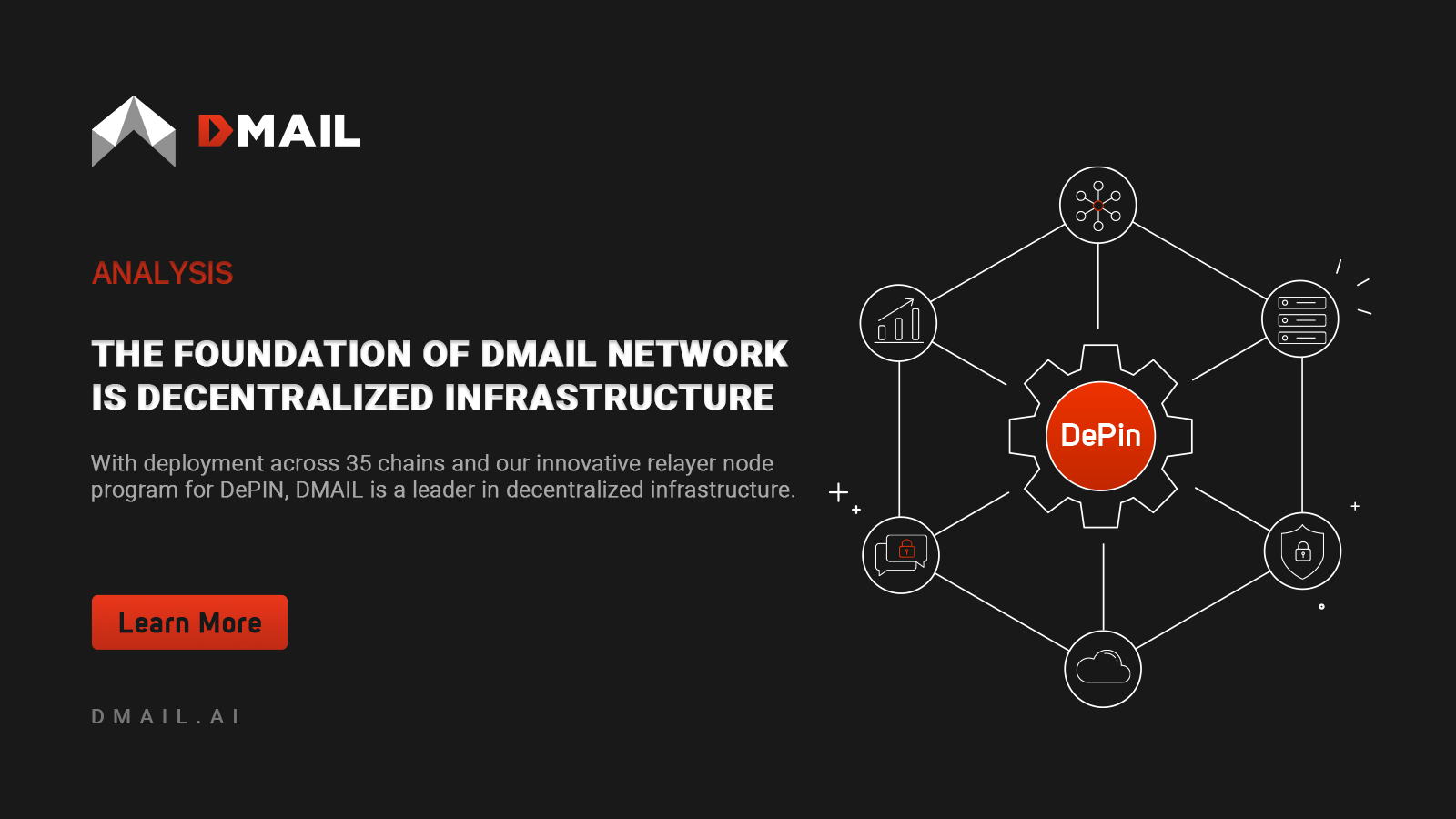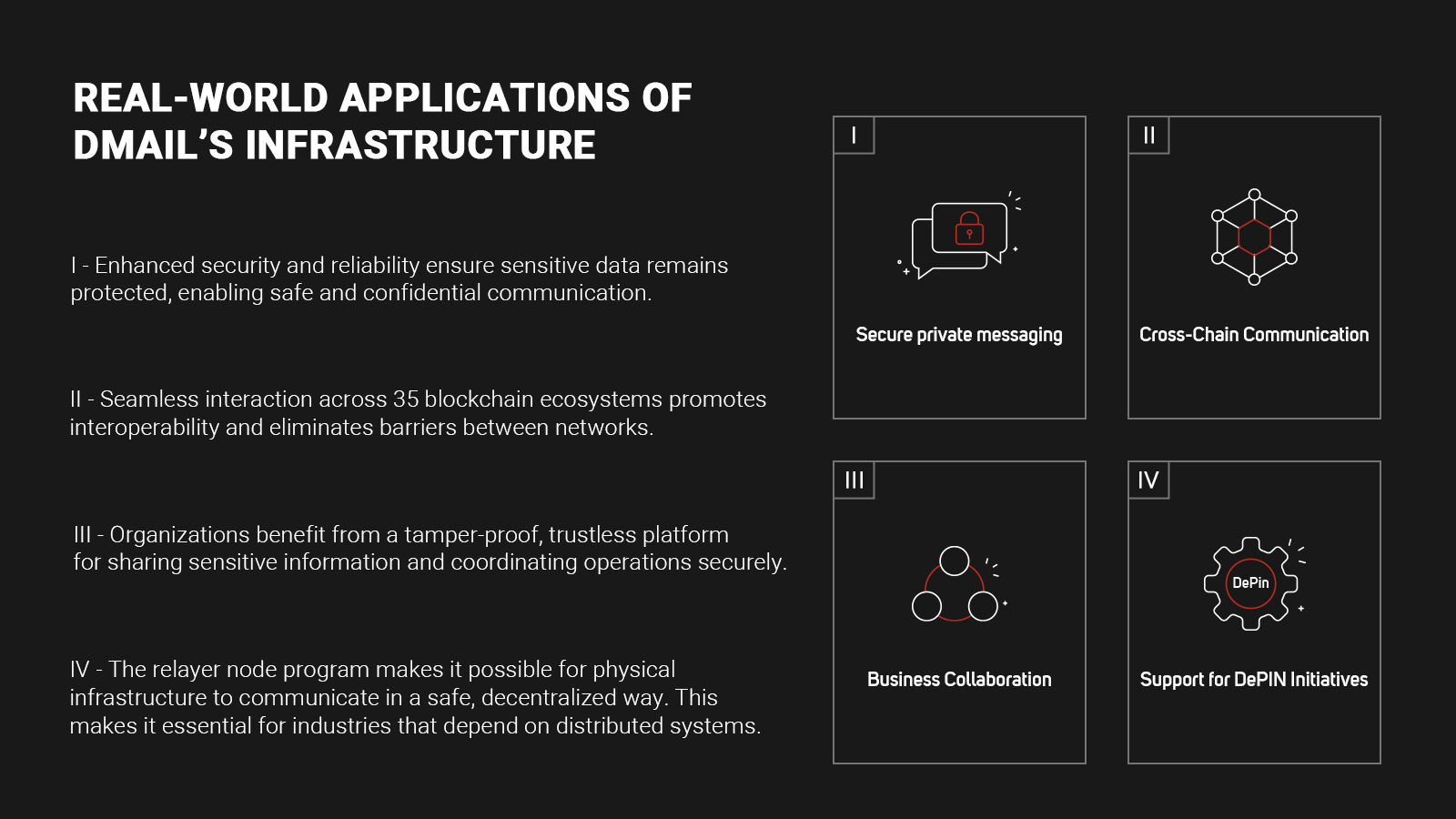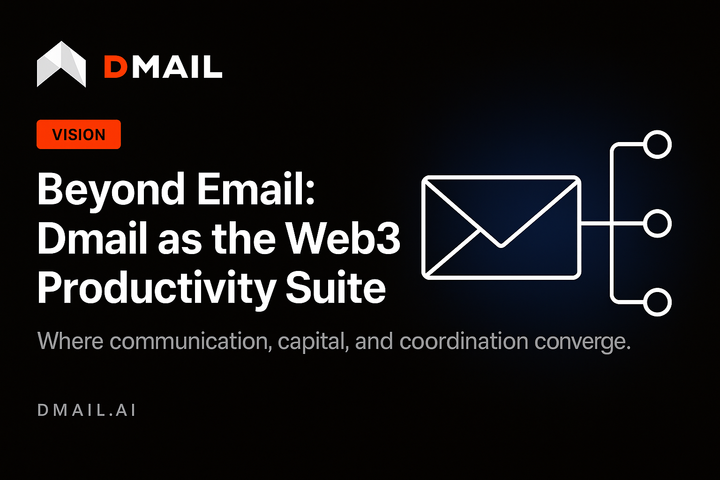The Foundation of DMAIL Network is Decentralized Infrastructure
DMAIL Network is building its Web3 communication platform on decentralized infrastructure, ensuring security, transparency, and resilience. With deployment across 35 chains and our innovative relayer node program for DePIN, DMAIL is a leader in decentralized infrastructure.

In the distributed era of Web3, where user empowerment and autonomy are the norm, centralized systems are unable to meet the demand for security, transparency, and resilience. The DMAIL Network redefines trustless architecture and strong decentralizing concepts by utilizing distributed infrastructure as the foundation of its ecosystem. DMAIL is establishing new standards for Web3 communication through the deployment of its innovative relayer node application for DePIN (Decentralized Physical Infrastructure Networks) across 35 blockchain networks.
Why Decentralized Infrastructure Matters
Decentralized infrastructure eliminates single points of failure and enhances overall resilience by distributing data and processes across a network of nodes. Unlike centralized systems, which are vulnerable to censorship, breaches, and disruptions, decentralized systems distribute control, improving transparency and security. This design is critical for Web3 communication as it ensures network integrity and availability while allowing users to retain sovereignty over their data.
Core Components of DMAIL’s Decentralized Infrastructure
To create a secure and resilient environment, the DMAIL Network integrates several critical components into its decentralized infrastructure:
- Multichain Interoperability: DMAIL’s cross chain presence ensures seamless connections across ecosystems, providing extensive compatibility.
- DePIN’s Relayer Node Program: These relayer nodes facilitate the efficient routing of messages without relying on centralized servers, playing a vital role in maintaining decentralized physical infrastructure.
- Distributed Storage Systems: By replacing centralized servers with distributed storage, DMAIL reduces the risk of data loss or compromise while enhancing resistance to censorship.
- Decentralized Identity (DID): Users gain full control over their identities, eliminating reliance on centralized providers and enhancing privacy and sovereignty.
- Peer-to-Peer (P2P) Architecture: Direct communication and data exchanges between users reduce dependence on intermediaries, increasing security.
How DMAIL’s Decentralized Infrastructure Stands Out
DMAIL sets itself apart from traditional systems by leveraging its decentralized infrastructure to provide critical advantages:
- Enhanced Resilience: By distributing data and operations across multiple nodes, DMAIL significantly reduces vulnerabilities to attacks or outages, ensuring robust system reliability.
- Censorship Resistance: Its decentralized architecture empowers users to communicate freely, even in restrictive environments, safeguarding the principles of open communication.
- Trustless Communication: By eliminating intermediaries, DMAIL fosters greater confidence in the system, providing users with a secure and transparent platform.
- Efficient Operations: The relayer node program ensures smooth and reliable communication processes within the ecosystem.
- User Sovereignty: With decentralized identity and storage, DMAIL enables users to maintain full control over their data, staying true to Web3’s foundational principles.

Real-World Applications of DMAIL’s Infrastructure
DMAIL’s decentralized infrastructure enables a variety of practical applications:
- Secure private messaging: Enhanced security and reliability ensure sensitive data remains protected, enabling safe and confidential communication.
- Cross-Chain Communication: Seamless interaction across 35 blockchain ecosystems promotes interoperability and eliminates barriers between networks.
- Business Collaboration: Organizations benefit from a tamper-proof, trustless platform for sharing sensitive information and coordinating operations securely.
- Support for DePIN Initiatives: The relayer node program makes it possible for physical infrastructure to communicate in a safe, decentralized way. This makes it essential for industries that depend on distributed systems.
Future Developments in Decentralized Infrastructure
DMAIL Network is constantly evolving to strengthen its decentralized infrastructure. Incorporating advanced storage functions like Binance's Greenfield, Filecoin and Arweave will further enhance scalability and data durability. We are planning to expand the relayer node program for DePIN, incorporating features that will enhance performance and decrease latency. Integrations in cross-chain infrastructure are also underway to ensure DMAIL remains compatible with emerging blockchain ecosystems while maintaining robust security and scalability.
Redefining Web3 Communication Through Decentralization
Decentralized infrastructure is at the heart of DMAIL’s mission to create a communication platform that embodies Web3 principles. By eliminating reliance on centralized systems, DMAIL ensures users retain control of their data, privacy, and interactions. Its multichain deployment and innovative relayer node program highlight the transformative potential of decentralized solutions for communication and infrastructure. As the decentralized ecosystem grows, DMAIL is leading the way, offering a resilient and trustless platform that redefines the future of Web3 communication.

Connect with Dmail: Website | Twitter | Discord | Github | Telegram





Comments ()